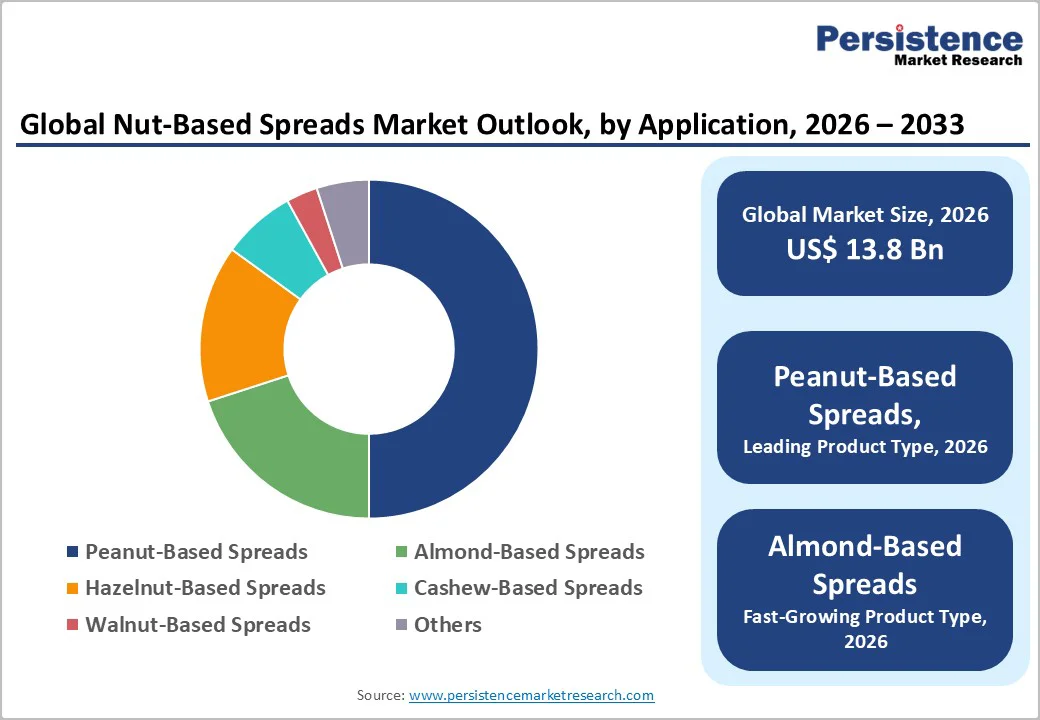ID: PMRREP34143| 199 Pages | 13 Dec 2025 | Format: PDF, Excel, PPT* | Food and Beverages

The global nut-based spreads market size is likely to be valued at US$ 13.8 billion in 2026, and is projected to reach US$ 20.4 billion by 2033, growing at a CAGR of 5.7% during the forecast period 2026-2033. Increasing consumer shift toward plant-based, protein-rich diets, rising health consciousness, and broader retail as well as e-commerce penetration for nut-based spreads underpin market growth. Further driving market expansion are product innovation, such as organic, low-sugar, flavored variants, and rising adoption in emerging economies. As a result, nut-based spreads are transitioning from niche health-food items to mainstream pantry staples across multiple geographies.
| Key Insights | Details |
|---|---|
| Nut-Based Spread Market Size (2026E) | US$ 13.78 Bn |
| Market Value Forecast (2033F) | US$ 20.4 Bn |
| Projected Growth (CAGR 2025 to 2032) | 5.7 % |
| Historical Market Growth (CAGR 2020 to 2025) | 5.2 % |

Rising Health Consciousness and Evolving Consumer Preferences
The growing consumer focus on healthier dietary patterns is reshaping the nut-based spreads market. The shift toward plant-based and protein-rich foods has increased demand for nut butters such as peanut, almond, and cashew, which provide convenient sources of plant-derived protein and healthy fats. This trend is especially visible among younger, health-conscious consumers and in regions with advanced lifestyle awareness. For example, in 2025, J.M. Smucker reported increased sales of Jif® peanut butter and Uncrustables® sandwiches, driven by a strong demand for peanut butter and portion-controlled products, reflecting how established brands are responding to modern consumption patterns.
At the same time, clean-label expectations and innovation in formulations are driving product evolution across the category. Consumers now favor natural, minimally processed spreads free from artificial additives, encouraging brands to introduce organic, sugar-reduced, and additive-free variants. Functional enhancements, such as added protein or digestion-supporting ingredients, combined with the growth of e-commerce, modern retail, and specialty health-food outlets, are improving accessibility, enabling premium positioning, and supporting wider adoption across diverse consumer groups.
Raw Material Volatility and Intensifying Price Sensitivity
The fluctuating costs of key raw nuts, such as peanuts, almonds, cashews, and hazelnuts, continue to challenge manufacturers due to climate variability, uneven harvest yields, and global trade disruptions. These supply-side uncertainties often translate into higher production costs, tighter margins, and occasional constraints in output, particularly for standard or low-margin product lines. As cost pressures ripple through the value chain, brands may be forced to adjust pricing or reduce promotional activity, which can influence consumer purchasing behavior. This volatility ultimately creates an unpredictable operating environment that restricts long-term planning and affects market stability.
Alongside supply pressures, nut-based spreads have to confront formidable competition from lower-priced alternatives such as seed-based spreads, jams, and traditional table spreads. Because nut-based products typically occupy a premium price tier, consumers with tighter budgets may shift toward more affordable options when prices rise. This sensitivity is more pronounced in regions with lower disposable income, where even slight cost increases can alter demand patterns. As premium formulations become costlier to maintain, market expansion may slow in certain segments, creating added pressure on manufacturers to optimize pricing while retaining value perception.
Premium Innovation and Expansion in Under-tapped Markets
Fledgling markets, particularly in Asia Pacific, present substantial potential as rising incomes, urban lifestyles, and evolving food habits increase acceptance of nut-based spreads. Even a small penetration among growing middle-class households can translate into significant incremental demand due to the region’s large population base. At the same time, expanding access through online retail and direct-to-consumer channels enables brands to reach new buyers without depending solely on traditional retail networks. This is especially valuable in developing regions where digital adoption is rising faster than physical distribution infrastructure.
Premiumization continues to strengthen the category by allowing brands to differentiate through organic, flavored, and functional varieties that appeal to health-conscious and higher-income consumers. Sugar-free, protein-enhanced, and clean-label formulations support stronger pricing power while reinforcing trust through transparent sourcing and sustainable practices. Online platforms further amplify these opportunities by enabling targeted marketing, subscription models, and small-batch or artisanal offerings.
Product Insights
Peanut-based spreads are expected to account for close to 50% market share in 2026 and continue to dominate due to affordability, widespread agricultural availability, and strong global consumer familiarity. Their established presence in both developed and emerging markets ensures steady volume demand, reinforcing their position as the backbone of the nut-based spreads category. Recent product innovations, such as Jif’s 2024 launch of a chocolate-peanut butter spread, demonstrate how brands are expanding offerings to meet evolving consumer preferences for lower-sugar, dessert-style options. Peanut butter and peanut powders also benefits from economies of scale and versatile applications, maintaining consistent adoption across households, foodservice, and retail formats. This entrenched consumption pattern supports long-term stability, particularly in price-sensitive markets where peanut-based options remain the most accessible.
Almond-based spreads are projected to register an estimated CAGR of 5.7% throughout the 2026–2033 forecast period. Their momentum is driven by increasing health consciousness and rising interest in premium, clean-label, and nutrient-rich spreads in regions with higher disposable incomes. Almond butter appeals strongly to consumers seeking alternatives rich in vitamin E, fiber, and healthy fats. Other variants, such as cashew, hazelnut, and walnut spreads, collectively hold a smaller share but benefit from niche demand for diverse flavors and dietary alternatives.
Distribution Channel Insights
Supermarkets and hypermarkets are likely to remain the dominant retail format, with an estimated 45% of the nut-based spread market revenue share in 2026, supported by extensive geographic coverage, broad product assortments, and strong consumer reliance on physical retail for grocery staples. Their leadership is reinforced by high-volume sales of mainstream products such as peanut butter and standard-price nut-based spreads. Specialist retailers, including health and organic stores, further complement this channel by offering premium and diversified nut-butter assortments.
Online retail is slated to be the fastest-growing channel, projected to display a CAGR of around 13% through 2033. E-commerce platforms enable broader access, especially among urban, digitally engaged, and health-focused consumers seeking variety, premium ingredients, or direct-to-consumer options. This channel also supports niche and artisanal brands through subscription models, customized blends, and small-batch offerings. Convenience stores and other channels contribute modestly, primarily serving impulse and on-the-go purchases, but their role remains secondary compared to supermarkets and online retail.

North America Nut-Based Spread Market Trends
North America is the largest market for nut-based spreads, holding an estimated 45% share in 2026. Wide consumption of peanut butter, coupled with an increasing adoption of almond and other premium spreads, drives market leadership. High household penetration, widespread retail networks, and consumer familiarity ensure stable demand across both standard and premium segments. Health-conscious trends and plant-based diet adoption encourage premiumization, including organic, low-sugar, and clean-label products.
The competitive landscape includes established global and regional brands, private-label products, and specialty entrants. Innovation in flavored, protein-enriched, and shelf-stable spreads enhances growth. Investments in sustainable sourcing, packaging improvements, and R&D strengthen differentiation. Well-defined regulatory frameworks for food safety and labeling reinforce consumer trust, supporting both volume and value growth, and solidifying North America’s leadership position in the global nut-based spreads market.
Europe Nut-Based Spread Market Trends
Europe is forecasted to account for an estimated 22% of the nut-based spread market share in 2026, owing to a rapidly developing interest in almond, hazelnut, and other premium spreads. Health-conscious and vegan consumers increasingly adopt clean-label, plant-based products. Regulatory harmonization across the European Union (EU) regarding food safety, labeling, and ingredient transparency boosts consumer confidence and facilitates cross-border distribution.
The market here benefits considerably from the presence of global brands and niche private-label players, with sustainability and ethical sourcing gaining prominence. Investments in organic, low-sugar, allergen-aware products, and innovative packaging support differentiation. Consumer awareness of nutritional benefits and plant-based diets drives adoption. Companies combining premium positioning, transparent sourcing, and novel flavors are well-positioned to capture additional market share and strengthen their foothold in Europe’s expanding nut-based spreads market.
Asia Pacific Nut-Based Spread Market Trends
The Asia Pacific market is projected to grow at around 12% CAGR from 2026 to 2033, making it the fastest-growing regional market. Prolific urbanization, increasing disposable incomes, and changing dietary habits, such as adoption of Western-style breakfasts and convenient snacks, fuel demand for peanut, almond, and other nut-based spreads. Even modest per-capita increase in adoption in populous countries such as China, India, and ASEAN nations can result in significant volume growth.
Local manufacturing advantages, including domestic nut production, reduce supply chain costs and support competitive pricing. Expanding modern retail and e-commerce platforms enhance product accessibility in urban and semi-urban areas. Regulatory standards are gradually aligning to ensure food safety and labeling compliance. Investment opportunities exist in manufacturing, packaging innovation, regional flavor development, and supply-chain expansion, making Asia Pacific a high-potential region for both mainstream and premium nut-butter products.

The global nut-based spreads market exhibits a moderately fragmented competitive landscape, comprising leading multinational brands, regional producers, specialty artisanal makers, and emerging digital-first DTC platforms. Established players such as J.M. Smucker, Hormel Foods, Unilever, and Ferrero maintain market leadership through diverse product portfolios, including peanut butter, almond butter, cashew butter, and hazelnut spreads, and innovative functional variants. Their competitive advantages stem from robust supply chains, large-scale production, consistent quality, and strong retail and e-commerce networks that enable broad distribution and premium positioning. Investment in R&D, clean-label formulations, sustainable sourcing, and value-added products such as protein-enhanced or flavored spreads further strengthens brand differentiation.
Regional and local manufacturers are focusing on catering to niche consumer segments by offering unique flavors, customized blends, and competitively priced products. Online platforms and subscription-based models allow artisanal and small-scale brands to reach health-conscious and urban consumers efficiently. Sustainability is increasingly critical, with brands adopting responsibly sourced nuts, eco-friendly packaging, and transparent labeling.
The global nut-based spreads market is projected to reach US$ 13.8 billion in 2026.
Rising demand for plant-based and protein-rich diets, consumer preference for clean-label and functional spreads, and the popularity of premium and flavored variants are driving the market.
The market is poised to witness a CAGR of 5.7% from 2026 to 2033.
Formulating premium and functional spreads, product launches in Asia Pacific, expanding digital retail and DTC channels, and developing region-specific flavors are the key market opportunities.
Leading market companies include J.M. Smucker, Hormel Foods, Unilever, and Ferrero.
| Report Attribute | Details |
|---|---|
| Historical Data/Actuals | 2020 - 2025 |
| Forecast Period | 2026 - 2033 |
| Market Analysis | Value: US$ Mn |
| Geographical Coverage |
|
| Segmental Coverage |
|
| Competitive Analysis |
|
| Report Highlights |
|
By Product Type
By Distribution Channel
By Region
Delivery Timelines
For more information on this report and its delivery timelines please get in touch with our sales team.
About Author